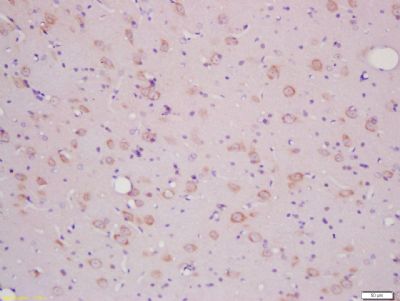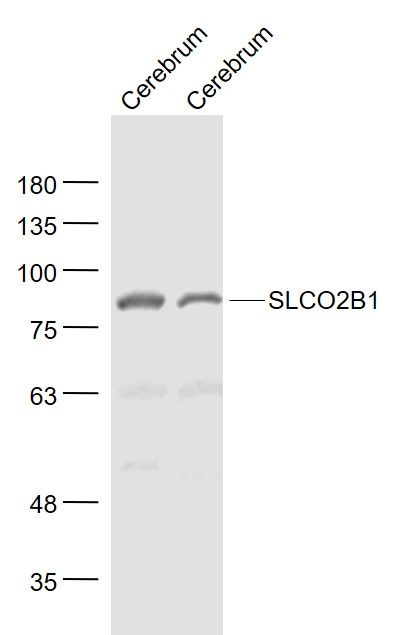SLCO2B1 Polyclonal Antibody
Purified Rabbit Polyclonal Antibody (Pab)
- 产品详情
- 实验流程
Application
| WB, IHC-P, IHC-F, IF, E |
|---|---|
| Primary Accession | O94956 |
| Reactivity | Rat, Dog, Bovine |
| Host | Rabbit |
| Clonality | Polyclonal |
| Calculated MW | 76699 Da |
| Physical State | Liquid |
| Immunogen | KLH conjugated synthetic peptide derived from human SLCO2B1 |
| Epitope Specificity | 531-630/709 |
| Isotype | IgG |
| Purity | affinity purified by Protein A |
| Buffer | 0.01M TBS (pH7.4) with 1% BSA, 0.02% Proclin300 and 50% Glycerol. |
| SUBCELLULAR LOCATION | Cell membrane; Multi-pass membrane protein. |
| SIMILARITY | Belongs to the organo anion transporter (TC 2.A.60) family. Contains 1 Kazal-like domain. |
| Important Note | This product as supplied is intended for research use only, not for use in human, therapeutic or diagnostic applications. |
| Background Descriptions | SLCO2B1 (solute carrier organic anion transporter family member 2B1), or Organic anion transporter B (OATP-B) mediates sodium-independent transport of organic anions. Unlike other related proteins, SLCO2B1 is expressed in many tissues, including liver, placenta, brain, heart and intestine. SLCO2B1 plays a role in the uptake of steroids and a number of drugs such as statins. |
| Gene ID | 11309 |
|---|---|
| Other Names | Solute carrier organic anion transporter family member 2B1, Organic anion transporter B, OATP-B, Organic anion transporter polypeptide-related protein 2, OATP-RP2, OATPRP2, Solute carrier family 21 member 9, SLCO2B1, KIAA0880, OATP2B1, OATPB, SLC21A9 |
| Dilution | WB=1:500-2000,IHC-P=1:100-500,IHC-F=1:100-500,IF=1:100-500,ELISA=1:5000-10000 |
| Format | 0.01M TBS(pH7.4) with 1% BSA, 0.09% (W/V) sodium azide and 50% Glyce |
| Storage | Store at -20 °C for one year. Avoid repeated freeze/thaw cycles. When reconstituted in sterile pH 7.4 0.01M PBS or diluent of antibody the antibody is stable for at least two weeks at 2-4 °C. |
| Name | SLCO2B1 (HGNC:10962) |
|---|---|
| Function | Mediates the Na(+)-independent transport of steroid sulfate conjugates and other specific organic anions (PubMed:10873595, PubMed:11159893, PubMed:11932330, PubMed:12724351, PubMed:14610227, PubMed:16908597, PubMed:18501590, PubMed:20507927, PubMed:22201122, PubMed:23531488, PubMed:25132355, PubMed:26383540, PubMed:27576593, PubMed:28408210, PubMed:29871943, PubMed:34628357). Responsible for the transport of estrone 3-sulfate (E1S) through the basal membrane of syncytiotrophoblast, highlighting a potential role in the placental absorption of fetal-derived sulfated steroids including the steroid hormone precursor dehydroepiandrosterone sulfate (DHEA-S) (PubMed:11932330, PubMed:12409283). Also facilitates the uptake of sulfated steroids at the basal/sinusoidal membrane of hepatocytes, therefore accounting for the major part of organic anions clearance of liver (PubMed:11159893). Mediates the intestinal uptake of sulfated steroids (PubMed:12724351, PubMed:28408210). Mediates the uptake of the neurosteroids DHEA-S and pregnenolone sulfate (PregS) into the endothelial cells of the blood-brain barrier as the first step to enter the brain (PubMed:16908597, PubMed:25132355). Also plays a role in the reuptake of neuropeptides such as substance P/TAC1 and vasoactive intestinal peptide/VIP released from retinal neurons (PubMed:25132355). May act as a heme transporter that promotes cellular iron availability via heme oxygenase/HMOX2 and independently of TFRC (PubMed:35714613). Also transports heme by-product coproporphyrin III (CPIII), and may be involved in their hepatic disposition (PubMed:26383540). Mediates the uptake of other substrates such as prostaglandins D2 (PGD2), E1 (PGE1) and E2 (PGE2), taurocholate, L-thyroxine, leukotriene C4 and thromboxane B2 (PubMed:10873595, PubMed:14610227, PubMed:19129463, PubMed:29871943, Ref.25). May contribute to regulate the transport of organic compounds in testis across the blood-testis-barrier (Probable). Shows a pH-sensitive substrate specificity which may be ascribed to the protonation state of the binding site and leads to a stimulation of substrate transport in an acidic microenvironment (PubMed:14610227, PubMed:19129463, PubMed:22201122). The exact transport mechanism has not been yet deciphered but most likely involves an anion exchange, coupling the cellular uptake of organic substrate with the efflux of an anionic compound (PubMed:19129463, PubMed:20507927, PubMed:26277985). Hydrogencarbonate/HCO3(-) acts as a probable counteranion that exchanges for organic anions (PubMed:19129463). Cytoplasmic glutamate may also act as counteranion in the placenta (PubMed:26277985). An inwardly directed proton gradient has also been proposed as the driving force of E1S uptake with a (H(+):E1S) stoichiometry of (1:1) (PubMed:20507927). |
| Cellular Location | Cell membrane; Multi-pass membrane protein. Basal cell membrane; Multi-pass membrane protein. Basolateral cell membrane; Multi-pass membrane protein. Apical cell membrane; Multi-pass membrane protein. Note=Expressed at the basal membrane of hepatocytes, syncytiotrophoblast and Sertoli cells (PubMed:11159893, PubMed:11932330, PubMed:12409283, PubMed:35307651). Localized to the basolateral membrane of enterocytes (PubMed:28408210). Also found at the apical membrane of enterocytes (PubMed:12724351, PubMed:28408210) |
| Tissue Location | Strongly expressed in the liver, at the sinusoidal membrane of the hepatocytes (PubMed:10873595, PubMed:11159893, PubMed:23531488). Expressed in the kidney (PubMed:11159893). Expressed in placental trophoblasts and syncytiotrophoblast (PubMed:11159893, PubMed:11932330, PubMed:12409283, PubMed:26277985). Expressed in the small intestine (PubMed:10873595, PubMed:11159893, PubMed:12724351, PubMed:23531488, PubMed:28408210). Expressed in the blood-brain barrier, in endothelial cells of brain capillaries (PubMed:11159893, PubMed:25132355). Expressed in the retina, in the inner nuclear layer and the inner plexiform layer (PubMed:25132355). Expressed in skelettal muscles (PubMed:23531488). In testis, primarily localized to the basal membrane of Sertoli cells and weakly expressed within the tubules (PubMed:10873595, PubMed:11159893, PubMed:35307651). Also expressed in pancreas, lung, heart, colon, ovary and spleen (PubMed:10873595, PubMed:11159893). Expressed in fetal brain, heart, kidney, liver, lung, skeletal muscle, spleen and pancreas (PubMed:10873595) [Isoform 3]: Predominant isoform compared to isoform 1 in liver. Also expressed in small intestine duodenum, kidney, brain, placenta, and skeletal muscle. |
Research Areas
For Research Use Only. Not For Use In Diagnostic Procedures.
Application Protocols
Provided below are standard protocols that you may find useful for product applications.
终于等到您。ABCEPTA(百远生物)抗体产品。
点击下方“我要评价 ”按钮提交您的反馈信息,您的反馈和评价是我们最宝贵的财富之一,
我们将在1-3个工作日内处理您的反馈信息。
如有疑问,联系:0512-88856768 tech-china@abcepta.com.























 癌症的基本特征包括细胞增殖、血管生成、迁移、凋亡逃避机制和细胞永生等。找到癌症发生过程中这些通路的关键标记物和对应的抗体用于检测至关重要。
癌症的基本特征包括细胞增殖、血管生成、迁移、凋亡逃避机制和细胞永生等。找到癌症发生过程中这些通路的关键标记物和对应的抗体用于检测至关重要。 为您推荐一个泛素化位点预测神器——泛素化分析工具,可以为您的蛋白的泛素化位点作出预测和评分。
为您推荐一个泛素化位点预测神器——泛素化分析工具,可以为您的蛋白的泛素化位点作出预测和评分。 细胞自噬受体图形绘图工具为你的蛋白的细胞受体结合位点作出预测和评分,识别结合到自噬通路中的蛋白是非常重要的,便于让我们理解自噬在正常生理、病理过程中的作用,如发育、细胞分化、神经退化性疾病、压力条件下、感染和癌症。
细胞自噬受体图形绘图工具为你的蛋白的细胞受体结合位点作出预测和评分,识别结合到自噬通路中的蛋白是非常重要的,便于让我们理解自噬在正常生理、病理过程中的作用,如发育、细胞分化、神经退化性疾病、压力条件下、感染和癌症。







